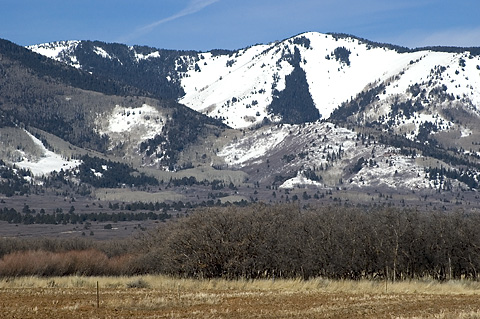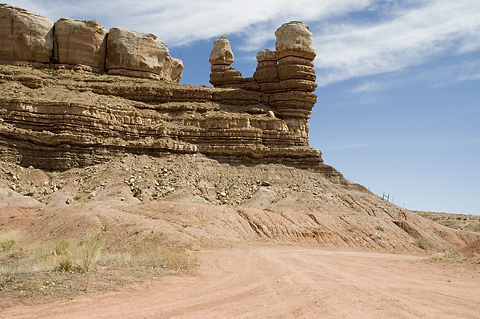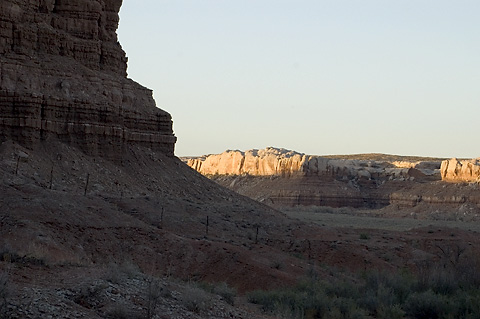
Saturday, April 8
Up early Saturday morning. Glenn and Merrill, joined us as we met the rest of the group at another motel at 5:45. The caravan headed out of town and down a rutted, dirt road, muddy in spots, worse in others, to search for the Gunnison Sage Grouse. Suddenly, we heard a call on the two-way radios that the grouse had been seen right on the road in front of the lead cars. Of course, being near the rear, we had no chance to see it. We continued on. Suddenly three birds flew in front of our car—Gunnison Sage Grouse. Very fleeting and not a very rewarding look, but still good enough to claim it as a lifer (especially since it is the only grouse in the area).
The group drove on down the road some more—almost reaching Colorado, which would have been a life state for me (I don’t consider a previous stop at the Denver airport as sufficient to claim it as a life state). We turned around and headed back. The caravan was stopped by a Division of Wildlife Resources officer who told every car that while we could stop on the public roads, the land on either side of the road was private property and we SHOULD NOT go on it (or else implied...). After he reached the last car, we proceeded back. On the way, we saw Northern Harrier, Tundra Swan, ducks, Horned Lark. An absolutely fantastic Golden Eagle, which I followed in the scope for a while as it flew off, Sage Thrasher, Say’s Phoebe, Mountain Bluebird, and Turkey Vulture among others.
Our car lagged behind, trying to find out what bird was making some strange calls. Merrill determined that it was a Prairie Dog. I did not see it, but after we left the dirt road and were on the road back to Monticello, we did see several on the side of the road. Life mammal for me, but when I went to enter them into AviSys, I found that there are several species of Prairie Dogs (who knew). I later determined that it was a Gunnison Prairie Dog.
We drove on to Devil’s Canyon and before we caught up with the group saw Mountain and Western Bluebirds, Red Crossbills, and Cassin’s Finch. When we did catch up, the group showed us where they had seen an Acorn Woodpecker on the way in. We could see the tree and “a” bird on it in the distance through our scope, but couldn’t really tell what it was. We birded the area some more and came up with White-breasted Nuthatch, Hairy Woodpecker, Pygmy Nuthatch, and Bushtit. Some of these were lifers for Joan.
We then left the group to look for the Acorn Woodpecker. When we got to “the spot,” we put up scopes only to find that the bird had flown. We waited a while and were rewarded with the sight of two Acorns. Well worth it. Also picked up a Sharp-shinned Hawk. We rejoined the group at Recapture Reservoir. Highlight there was a Common Loon in full breeding plumage (although at a distance). We are accustomed to only seeing them in “drab” winter plumage, so this was a nice sight.
We then drove Glenn and Merrill back to the motel as they had to pick up their truck. While waiting, a local drove up to us and asked if we had seen the horse’s head. We were quite puzzled and she pointed us to the mountain and showed us how the snow and the trees formed the shape of a horse’s head. She said the people in the town say they live under the horse’s head.

We all picked up a not very good lunch, rejoined the group, and went on to the Blanding Sewage Ponds, which had a good number of ducks in the distance, but we didn’t add to the trip list. Glenn and Merrill had to leave us and return home. Now, we were on our own within a large group of birders we didn’t know. However, everyone was quite friendly and made us feel as though we were old friends and part of the group!

Then on to a pond amidst some extraordinary Red Rock scenery in Bluff. Saw a Great Blue Heron soaring against the rocks, beautiful sight, then landing high up on the rocks. At the pond, someone played rail calls in hopes of getting one to answer and one did. Or so we thought. After much hunting, a woman said it could be a grackle and she finally located a Great-tailed Grackle doing an imitation of the rail. While there, we also saw some White-throated Sparrows and a Ruby-crowned Kinglet, which put on quite a display, showing off its brilliant red crown in the sunlight.
In the town of Bluff, we stopped to look at some doves—White-winged and Eurasian Collared. (Who would believe that we wouldn’t get a Mourning Dove on the whole trip.) Then on to Sand Island Park. We stopped to look at the petroglyphs carved into one of the rocks—men with ladders, the hump-backed flute player, birds, antelope, very interesting. Then looked for birds. Not too much: Common Raven, White-crowned Sparrow, another Ruby-crowned Kinglet, and a Gray Flycatcher, which we saw several times. Some in the group pointed out that it flicked its tail downwards, a diagnostic sign.

Next on to Cottonwood Canyon (as we’re told, one of about 27 Cottonwood Canyons in the state!). Couple of nice highlights here. The same woman who had found the Great-tailed Grackle, she had a great eye and ear, spotted a small sparrow. After much debate, comparison of photo (taken by someone else) with the field guides, it was determined to be a Clay-colored Sparrow. Rather uncommon and a good find. Speaking of finds, Joan found an owl pellet, which was dissected and contained the leg of a small bird. Quite interesting. As a reward, Joan was given a horseshoe that someone had found. We heard a little bird singing its heart out. Since it was varying its song quite a bit, we thought it would be a thrasher. Joan finally located the little fellow—a Rock Wren. Amazing how much volume can come from such a tiny bird.
We left the park and had a not good dinner (can’t remember the name of the place to avoid) and then went owling at the River Trail in Bluff. Two Western Screech-Owls responded to calls that were played. Easy to see them in the bright lights that some members of the group carried. (There was some talk of lumen envy as one claimed his light was twice as bright as the other’s.) Anyhow, a lifer for Joan and me. Then on to Devil’s Canyon to look for the Saw-whet Owls that had been seen the night before. We searched, played the calls, had someone imitate the calls, but to no avail. Two women who joined us late, said that they had heard one calling up the road. Joan and I were tired and opted to return to the motel instead of pursuing the owl. We later learned that those who went did see it. However, the extra time sleeping was good.
Day totals: 54 species and 2 lifers; trip totals: 116 species; 6 lifers.
Day 9: The Trip Ends
The SongStar Home Page
Drop me a note
Copyright © 2006 by Glenn Barlow and Joan & Richard Becker